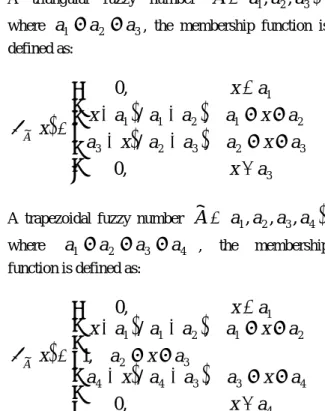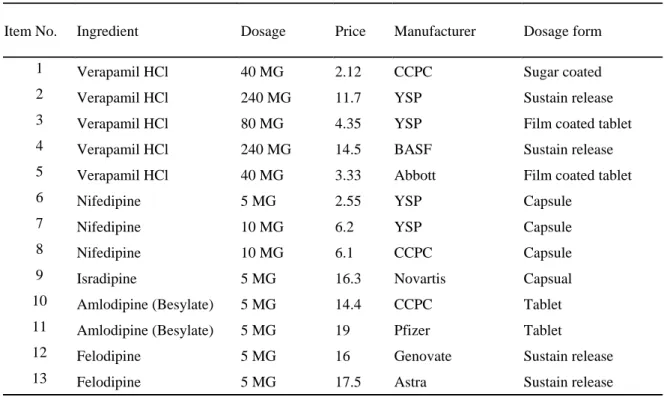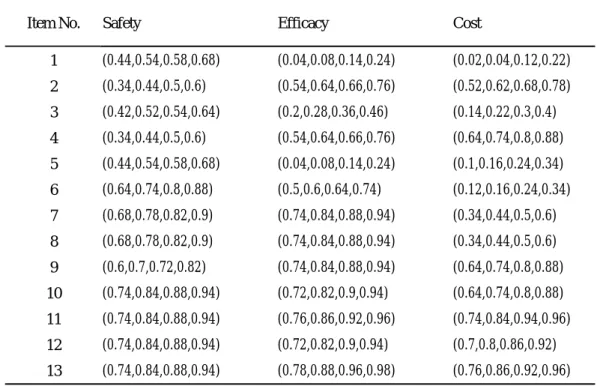Evaluating New Drugs by Fuzzy Inference System
全文
(2) Int. Computer Symposium, Dec. 15-17, 2004, Taipei, Taiwan.. And fuzzy number is a fuzzy subset in the universe of discourse X that is both convex [5,6] and normal [7,8]. Theα-cut is defined as:. {. ~ A α = x µ A~ ( x ) ≥ α. Table1. The linguistic variables corresponding trapezoidal fuzzy number For importance weighting and rating. }. Linguistic weighting variable. ~ A = (a1 , a 2 , a3 ) ,. A triangular fuzzy number. with. Corresponding trapezoidal fuzzy number. Very Low (VL). (0.0, 0.0, 0.1, 0.2). where a1 ≤ a 2 ≤ a3 , the membership function is. Low (L). (0.1, 0.2, 0.2, 0.3). defined as:. Medium Low (ML). (0.2, 0.3, 0.4, 0.5). 0, x < a1 ⎧ ⎪ ( x − a ) / (a − a ), a ≤ x ≤ a ⎪ 1 1 2 1 2 µ A~ ( x ) = ⎨ ( ) ( ) − − ≤ ≤ a x / a a , a x a 2 3 2 3 ⎪ 3 ⎪⎩ 0, x > a3. Medium (M). (0.4, 0.5, 0.5, 0.6). Medium High (MH). (0.5, 0.6, 0.7, 0.8). High (H). (0.7, 0.8, 0.8, 0.9). Very High (VH). (0.8, 0.9, 1.0, 1.0). 2.2. Mamdani fuzzy inference. ~ A trapezoidal fuzzy number A = (a1 , a 2 , a 3 , a 4 ) , where. The components of fuzzy Mamdani algorithm are input, output and rules (Mandani et al, 1975). Mamdani’s fuzzy inference method is one of the most commonly seen fuzzy methodologies. Mamdani’s effort was based on Loft Zadeh’s fuzzy algorithms for decision process and complex systems. The basic structure is drawn as Fig 1. Information flows from left to right and aggregate the outputs of rules. The last step is defuzzification.. a1 ≤ a 2 ≤ a3 ≤ a 4 , the membership. function is defined as:. 0, x < a1 ⎧ ⎪ ( x − a1 ) / (a1 − a 2 ), a1 ≤ x ≤ a 2 ⎪ µ A~ (x ) = ⎨1, a 2 ≤ x ≤ a3 ⎪(a 4 − x ) / (a 4 − a3 ), a3 ≤ x ≤ a 4 ⎪ 0, x > a4 ⎩ This study utilizes trapezoidal fuzzy numbers. The linguistic weighting variables, linguistic rating variables and corresponding fuzzy numbers are shown as Table1. If A = (a1 , a 2 , a 3 , a 4 ) and B = (b1 , b2 , b3 , b4 ). ~. ~. Fig 1. The process fuzzy inference. are two positive trapezoidal fuzzy numbers, then. ~ ~ A ⊕ B = (a1 + b1 , a 2 + b2 , a3 + b3 , a 4 + b4 ) [9], ~ then the average of A i (i = 1,2…n) can be as the. The Mamdani fuzzy inference uses crisp value as input and aggregates every membership function from rules. The final membership function is then defuzzified with centroid method.. follows.. 1⎛ n ⎜ ∑ ai1 , n ⎝ i =1. n. ∑ ai 2 , i =1. n. ∑ ai 3 , i =1. n. ∑a i =1. i4. ⎞ ⎟ ⎠. And the defuzzification value of trapezoidal fuzzy number. ~ A = (a1 , a 2 , a 3 , a 4 ) is defined to be. (a1 + a 2 + a3 + a4 ) / 4. [7,10]. Fig 2. Mamdani’s fuzzy inference system. 794.
(3) Int. Computer Symposium, Dec. 15-17, 2004, Taipei, Taiwan.. contraindications, precautions and elderly patients are also critical considerations [14]. Efficacy: Main ingredients, official indications, dosage form, half-life, frequency of delivery and route of administration are considered by most medical institutions [ 15 , 16 ] Equivalency of generic drugs is also an important factor of evaluating efficacy [15, 12] Cost: Cost seems to be the most important among health care providers. Some medical institutions set up medical expenditure and quality review panel to lower the cost while remain the same quality. Drugs reimbursed by the BNHI are also limited to those listed [ 17 ]. Individuals covered by BNHI are required to copay on medicine costs [18]. Thus, health care provider should also consider the copayment that patients would be charged.. 2.3. Delphi Method Delphi method is group decision process about the likelihood that certain events will occur. This method nowadays has been applied in many fields such as environmental, marketing and sales forecasting. In original Delphi process, the process consists only three components: structuring of information flow; feedback to the participants; and anonymity for the participants. Fowles (1978) further described the following steps for the Delphi method:. 1. Forming a team to undertake and monitor a Delphi on a given subject. Selection of panels to participate in the exercise. Developing the first round Delphi questionnaire Testing the questionnaire for proper wording. Transmission of the questionnaires to the team member 6. Analyzing the first round responses. 7. Prepare for the second round questionnaires. 8. Transmission of the second round questionnaires to the panelists 9. Analysis of the second round responses (Steps 7 to 9 are reiterated as long as desired or necessary to achieve consensus in the results.) 10. Preparing a report by the analysis team to present the conclusions of the exercise 2. 3. 4. 5.. 4. Methodology The proposed method was divided into two phases. In first phase, the DTC commits agreement on the rules of choosing drugs. In the second phase, all members of DTC utilize language variables on each criterion and send back to the committee for conclusion.. 3. Criteria of selecting new drugs. Phase I (Rules Discovery) In this phase, DTC members define how many linguistic levels of each criterion and the rules among input and output relationships. Then, make sure each linguistic level should link to any corresponding criteria. There is an example:. The decision-making on selecting new drugs is complex and involves clusters of factors; include the hottest issue-cost (Singer, Martin, Giacomini, & Purdy, 2000). And the decisions making by DTC should base on evidence-based medicine (EBM working Group, 1992). That’s why non-scientific forms of evidence are not recorded in literature. [1] Criteria utilized by DTCs are various from hospital to hospital. Some medical intuitions in Taiwan use detail criteria such as pharmacodynamics, pharmacokinetic parameters, adverse reactions, interactions, cost and ease of administrations [11]. Researchers generalize that DTCs make decisions based on evidence of safety, efficacy, cost-effectiveness [2,12], BNHI announced price, and brands [13]. Though, there are many factors that influence physicians’ prescribing behavior, this study concerns only criteria during drug selection. After screening on literature and practical process among hospitals, the decision criteria are based on the following three aspects:. “The better the safety is, the higher the priority will gain.” in which seven levels of safety is mapping to seven levels of priority. Thus, rules generated: If “Safety is VeryHigh” then “Priority is VeryHigh” If “Safety is High” then “Priority is High” If “Safety is MediumHigh” then “Priority is MediumHigh” If “Safety is Medium” then “Priority is Medium” If “Safety is MediumLow” then “Priority is MediumLow” If “Safety is Low” then “Priority is Low” If “Safety is VeryHigh” then “Priority is VeryLow” The process follows the steps of Delphi method. Under the same purpose, the results of this phase can be reused. For example, the DTC want to select three calcium channel block anti-hypertension agents from candidates. They can use former rules, otherwise, the new DTC can build a new set of rules.. Safety: Safety issue involves pharmacodynamics, pharmacokinetics and delivery of drugs. Typically, drugs with broad therapeutic index are better then those with narrow therapeutic index. Adverse effects,. Phase II (Evaluation Process) Step1. DTC, then, collect information on each candidate from all members.. 795.
(4) Int. Computer Symposium, Dec. 15-17, 2004, Taipei, Taiwan.. Step2. Calculate the mean of each criterion and the importance weighing of each criterion. Step3. Utilize Mamdani fuzzy inference algorithm to calculate the priority value; use the defuzzyfied mean of each criterion as input value and consensus rules as inference rules. Step4. Rank the priority value to allocate the candidates.. Calculate the mean of fuzzy ratings of each candidate as input value. Step 1. Linguistic variables on each criterion of each item were recorded. Step 2. Calculate the means. The criteria means of each item were illustrated as Table 4 Step 3. Defuzzy each membership of Table 4 as input of Mamdani’s inference system. The fuzzy inference diagram is shown as Fig 3.. 5. Verification and comparison The DTC is arisen for selecting three calcium channel block antihypertensive agents of different ingredient among candidates. The basic information of candidates is shown as Table 2. In the first phase, the consensus of DTC members can therefore generate rules. There are rules illustrated as Table 3. The members of the committee seem reluctant to weight the importance of each criterion. Most of the members indicated that all criteria are important equally. In this occurrence, an alternative measurement should apply. Members of the committee were then asked to rank the importance on criteria.. Fig 3. Fuzzy inference diagram Step 4. Rank the priority value and select 3 candidates of different ingredient. The result is shown in Table 5.. Processes on to the second phase, the linguistic ratings were given on each item and then recorded.. Table 2. Basic information of candidates Item No.. Ingredient. Dosage. Price. Manufacturer. Dosage form. 1. Verapamil HCl. 40 MG. 2.12. CCPC. Sugar coated. 2. Verapamil HCl. 240 MG. 11.7. YSP. Sustain release. 3. Verapamil HCl. 80 MG. 4.35. YSP. Film coated tablet. 4. Verapamil HCl. 240 MG. 14.5. BASF. Sustain release. 5. Verapamil HCl. 40 MG. 3.33. Abbott. Film coated tablet. 6. Nifedipine. 5 MG. 2.55. YSP. Capsule. 7. Nifedipine. 10 MG. 6.2. YSP. Capsule. 8. Nifedipine. 10 MG. 6.1. CCPC. Capsule. 9. Isradipine. 5 MG. 16.3. Novartis. Capsual. 10. Amlodipine (Besylate). 5 MG. 14.4. CCPC. Tablet. 11. Amlodipine (Besylate). 5 MG. 19. Pfizer. Tablet. 12. Felodipine. 5 MG. 16. Genovate. Sustain release. 13. Felodipine. 5 MG. 17.5. Astra. Sustain release. 796.
(5) Int. Computer Symposium, Dec. 15-17, 2004, Taipei, Taiwan.. Table 3 The fuzzy inference rules 1. If (Safety is VL) or (Efficacy is VL) or (Cost is VH) then (Priority is VL) 2. If (Safety is L) or (Efficacy is L) or (Cost is H) then (Priority is L) 3. If (Safety is ML) or (Efficacy is ML) or (Cost is MH) then (Priority is ML) 4. If (Safety is M) or (Efficacy is M) or (Cost is M) then (Priority is M) 5. If (Safety is MH) or (Efficacy is MH) or (Cost is ML) then (Priority is MH) 6. If (Safety is H) or (Efficacy is H) or (Cost is L) then (Priority is H) 7. If (Safety is VH) or (Efficacy is VH) or (Cost is VL) then (Priority is VH) 8. If (Safety is MH) and (Efficacy is VL) then (Priority is MH) 9. If (Safety is M) and (Efficacy is VL) then (Priority is M) 10. If (Safety is ML) and (Efficacy is VL) then (Priority is ML) 11. If (Safety is MH) and (Efficacy is L) then (Priority is MH) 12. If (Safety is M) and (Efficacy is L) then (Priority is M) 13. If (Safety is ML) and (Efficacy is L) then (Priority is ML) 14. If (Efficacy is VL) and (Cost is VH) then (Priority is VL) 15. If (Efficacy is VL) and (Cost is H) then (Priority is L) 16. If (Efficacy is L) and (Cost is VH) then (Priority is VL) 17. If (Efficacy is L) and (Cost is H) then (Priority is L) Table 4. Average membership of each item Item No.. Safety. Efficacy. Cost. 1. (0.44,0.54,0.58,0.68). (0.04,0.08,0.14,0.24). (0.02,0.04,0.12,0.22). 2. (0.34,0.44,0.5,0.6). (0.54,0.64,0.66,0.76). (0.52,0.62,0.68,0.78). 3. (0.42,0.52,0.54,0.64). (0.2,0.28,0.36,0.46). (0.14,0.22,0.3,0.4). 4. (0.34,0.44,0.5,0.6). (0.54,0.64,0.66,0.76). (0.64,0.74,0.8,0.88). 5. (0.44,0.54,0.58,0.68). (0.04,0.08,0.14,0.24). (0.1,0.16,0.24,0.34). 6. (0.64,0.74,0.8,0.88). (0.5,0.6,0.64,0.74). (0.12,0.16,0.24,0.34). 7. (0.68,0.78,0.82,0.9). (0.74,0.84,0.88,0.94). (0.34,0.44,0.5,0.6). 8. (0.68,0.78,0.82,0.9). (0.74,0.84,0.88,0.94). (0.34,0.44,0.5,0.6). 9. (0.6,0.7,0.72,0.82). (0.74,0.84,0.88,0.94). (0.64,0.74,0.8,0.88). 10. (0.74,0.84,0.88,0.94). (0.72,0.82,0.9,0.94). (0.64,0.74,0.8,0.88). 11. (0.74,0.84,0.88,0.94). (0.76,0.86,0.92,0.96). (0.74,0.84,0.94,0.96). 12. (0.74,0.84,0.88,0.94). (0.72,0.82,0.9,0.94). (0.7,0.8,0.86,0.92). 13. (0.74,0.84,0.88,0.94). (0.78,0.88,0.96,0.98). (0.76,0.86,0.92,0.96). Table 5a. Selected drugs with fuzzy inference system. Priority value. Item No. Ingredient. Dosage. Price. Manufacturer. Dosage form. YSP. Capsule. 0.71817. 7. Nifedipine. 10 MG. 6.2. 0.58375. 9. Isradipine. 5 MG. 16.3 Novartis. Capsule. 0.55927. 10. Amlodipine (Besylate). 5 MG. 14.4 CCPC. Tablet. 797.
(6) Int. Computer Symposium, Dec. 15-17, 2004, Taipei, Taiwan.. Table 5b. Selected drugs with simple aggregating method (no weighted). Priority value. Item No. Ingredient. Dosage. Price. Manufacturer. Dosage form. YSP. Capsule. 2.17500. 7. Nifedipine. 10 MG. 6.2. 1.93000. 10. Amlodipine (Besylate). 5 MG. 14.4 CCPC. 1.87500. 12. Felodipine. 5 MG. From Table 5a and 5b, it is observed that Isradipine (the 9th item) has higher price and is selected by fuzzy inference system. The fuzzy inference system has already considered the importance of each criterion while simple aggregation has not. Therefore, it could be unnecessary to weight the importance of criteria. But it still needs further evaluations to confirm that.. 6. Conclusion The fuzzy logic concept has been utilized not only in the multiple criteria decision making arena, but also in medical device controlling and as well as in pharmacological applications [ 19 ]. Advanced computation power makes the complex inferences possible. And this paper shows the feasibility of adopting drugs by fuzzy inference system.. Reference [1] K Neil Jenkings, Nick Barber, “What constitutes evidence in hospital new drug decision making?”, Social Science & Medicine 58 (2004) 1757–1766 [2] K. Douglas et al, ”Priority setting in a hospital drug formulary: a qualitative case study and evaluation”, Health Policy 66 (2003) 295-303 [3] Hollander, C. Stanley, and Kathleen M. Rassuli (1999),“Shopping with Other People’s Money: The Marketing Management Implications of Surrogate-Medicated Consumer Decision Making,” Journal of Marketing, Vol. 63, April, pp. 102-18. [4] International Society on Multiple Criteria Decision Making [5] G.J. Klir,B. Yan,Fuzzy Sets and Fuzzy Logic Theory and Applications,Prentice- Hall, London,1995. [6] H.-J. Zimmermann, Fuzzy Set Theory and its Applications, second ed.,Kluwer Academic Publishers, Dordrecht, 1991. [7] A. Kaufmann,M.M. Gupta, Fuzzy Mathematical Models in Engineering and Management Science, North-Holland,Amsterdam 1988. [8] S. Mabuchi, An approach to the comparison of fuzzy subsets with an a-cut dependent index,IEEE Transactions on Systems, Man,and Cybernetics SMC-18 (2) (1988) 264–272.. 798. 16. Genovate. Tablet Sustain release. [9] C.T. Chen,A study of fuzzy group decision-making method,in: 1998 6th National Conference on Fuzzy Theory and Its Applications,1998. [10] A. Kaufmann,M.M. Gupta,Introduction to Fuzzy Arithmetic Theory and Application,Van Nostrand Reinhold,New York, 1991. [11] Veterans General Hospital, http://www. vghtpe. gov.tw/ ~pharm/ newdrug/ newdrug.htm [12] Department of health, Taiwan, “Structure and Content of Clinical Study Reports”, April 2003 [13] H.-C. Chiang, “Investigating the Impact on Doctor’s Repurchase Intention of Drug Prescription”, 2002 [14] F.-Y. Yeh, “Association between adverse drug reaction and potentially inappropriate medication use in the elderly: an ambulatory service study in a medical center in Taiwan”, 2001 [15] http://www.vghtpe.gov.tw [16] Y.-L. Ke, “The Impact of Promotion Program on Physicians’ Choice Behavior”, 2003 [17] BNHI, “Chapter one: general principles”, http://www.nhi.gov.tw, [18] BNHI, “Q&A: V. Copayment”, http:// www.nhi.gov.tw/ 04personal/ personal_925.htm [19] A. Beth et al, “Fuzzy pharmacology: theory and applications”, Trends in pharmacological sciences Vol.23 No.9 Sep2002.
(7)
數據




相關文件
Keywords: Requesting Song, Information Retrieval, Knowledge Base, Fuzzy Inference, Adaptation Recommendation System... 致
Keywords: Mobile ad-hoc network, Cluster manager electing, Fuzzy inference rule, Workload sharing, Backup manager... 致謝 致謝
• An algorithm is any well-defined computational procedure that takes some value, or set of values, as input and produces some value, or set of values, as output.. • An algorithm is
Trace of display recognition and mental state inference in a video labelled as undecided from the DVD [5]: (top) selected frames from the video sampled every 1 second; (middle) head
– One of the strengths of CKC Chinese Input System is that it caters for the input of phrases to increase input speed.. The system has predefined common Chinese phrases, such
• One of the strengths of CKC Chinese Input System is that it caters for the input of phrases to increase input speed. The system has predefined common Chinese phrases, such
First, when the premise variables in the fuzzy plant model are available, an H ∞ fuzzy dynamic output feedback controller, which uses the same premise variables as the T-S
This research is to integrate PID type fuzzy controller with the Dynamic Sliding Mode Control (DSMC) to make the system more robust to the dead-band as well as the hysteresis